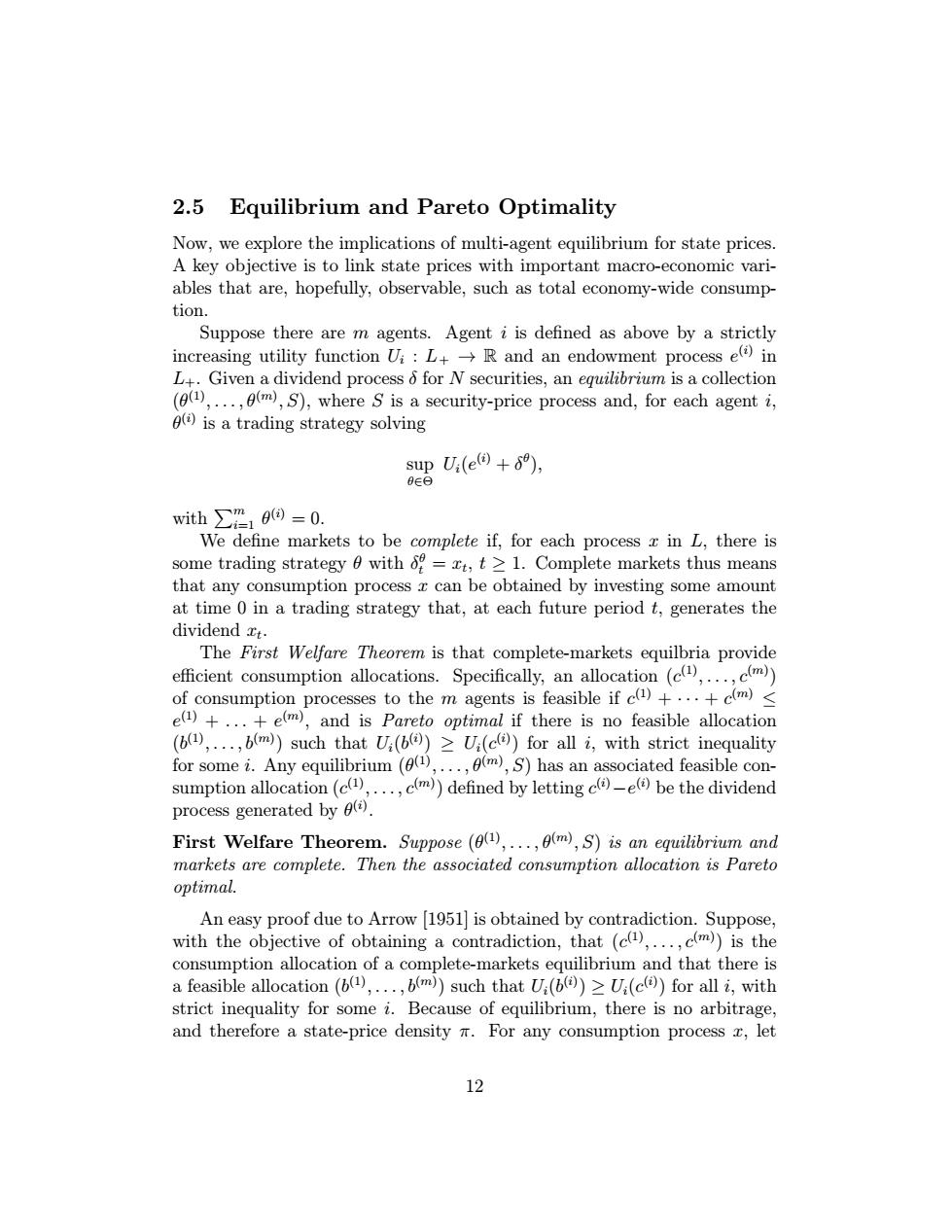正在加载图片...

2.5 Equilibrium and Pareto Optimality Now,we explore the implications of multi-agent equilibrium for state prices. A key objective is to link state prices with important macro-economic vari- ables that are,hopefully,observable,such as total economy-wide consump- tion. Suppose there are m agents.Agent i is defined as above by a strictly increasing utility function Ui:L+R and an endowment process e()in L+.Given a dividend process 6 for N securities,an equilibrium is a collection ((1),...,(m),S),where S is a security-price process and,for each agent i, 0()is a trading strategy solving sup U:(e()+80), 0∈日 with∑e@-0. We define markets to be complete if,for each process x in L,there is some trading strategy 0 with 6o=xt,t>1.Complete markets thus means that any consumption process x can be obtained by investing some amount at time 0 in a trading strategy that,at each future period t,generates the dividend zt. The First Welfare Theorem is that complete-markets equilbria provide efficient consumption allocations.Specifically,an allocation (c),.cm) of consumption processes to the m agents is feasible if c()+.·+cm)≤ e(1)+...+e(m),and is Pareto optimal if there is no feasible allocation (6(1),...,b(m))such that U(b)U(c())for all i,with strict inequality for some i.Any equilibrium(a四,.,em),S)has an associated feasible con- sumption allocation (c(),....c(m))defined by lettingc(e()be the dividend process generated by a(). First Welfare Theorem.Suppose (),...,0(m),S)is an equilibrium and markets are complete.Then the associated consumption allocation is Pareto optimal. An easy proof due to Arrow [1951 is obtained by contradiction.Suppose, with the objective of obtaining a contradiction,that (c),...,c(m))is the consumption allocation of a complete-markets equilibrium and that there is a feasible allocation ((1),...,b(m))such that U:(b(>U(c())for all i,with strict inequality for some i.Because of equilibrium,there is no arbitrage, and therefore a state-price density For any consumption process z,let 122.5 Equilibrium and Pareto Optimality Now, we explore the implications of multi-agent equilibrium for state prices. A key objective is to link state prices with important macro-economic variables that are, hopefully, observable, such as total economy-wide consumption. Suppose there are m agents. Agent i is defined as above by a strictly increasing utility function Ui : L+ → R and an endowment process e(i) in L+. Given a dividend process δ for N securities, an equilibrium is a collection (θ(1),...,θ(m) , S), where S is a security-price process and, for each agent i, θ(i) is a trading strategy solving sup θ∈Θ Ui(e(i) + δθ ), with Pm i=1 θ(i) = 0. We define markets to be complete if, for each process x in L, there is some trading strategy θ with δθ t = xt, t ≥ 1. Complete markets thus means that any consumption process x can be obtained by investing some amount at time 0 in a trading strategy that, at each future period t, generates the dividend xt. The First Welfare Theorem is that complete-markets equilbria provide efficient consumption allocations. Specifically, an allocation (c(1),...,c(m) ) of consumption processes to the m agents is feasible if c(1) + ··· + c(m) ≤ e(1) + ... + e(m) , and is Pareto optimal if there is no feasible allocation (b(1),...,b(m) ) such that Ui(b(i) ) ≥ Ui(c(i) ) for all i, with strict inequality for some i. Any equilibrium (θ(1),...,θ(m) , S) has an associated feasible consumption allocation (c(1),...,c(m) ) defined by letting c(i) −e(i) be the dividend process generated by θ(i) . First Welfare Theorem. Suppose (θ(1),...,θ(m) , S) is an equilibrium and markets are complete. Then the associated consumption allocation is Pareto optimal. An easy proof due to Arrow [1951] is obtained by contradiction. Suppose, with the objective of obtaining a contradiction, that (c(1),...,c(m) ) is the consumption allocation of a complete-markets equilibrium and that there is a feasible allocation (b(1),...,b(m) ) such that Ui(b(i) ) ≥ Ui(c(i) ) for all i, with strict inequality for some i. Because of equilibrium, there is no arbitrage, and therefore a state-price density π. For any consumption process x, let 12